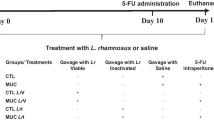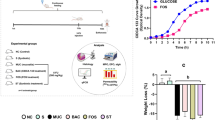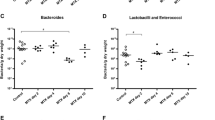Abstract
Purpose
Lactobacillus acidophilus is widely used for gastrointestinal disorders, but its role in inflammatory conditions like in chemotherapy-induced mucositis is unclear. Here, we report the effect of L. acidophilus on 5-fluorouracil-induced (5-FU) intestinal mucositis in mice.
Methods
Mice weighing 25–30 g (n = 8) were separated into three groups, saline, 5-FU, and 5-FU + L. acidophilus (5-FU-La) (16 × 109 CFU/kg). In the 5-FU-La group, L. acidophilus was administered concomitantly with 5-FU on the first day and alone for two additional days. Three days after the last administration of L. acidophilus, the animals were euthanized and the jejunum and ileum were removed for histopathological assessment and for evaluation of levels of myeloperoxidase activity, sulfhydryl groups, nitrite, and cytokines (TNF-α, IL-1β, CXCL-1, and IL-10). In addition, we investigated gastric emptying using spectrophotometry after feeding a 1.5-ml test meal by gavage and euthanasia. Data were submitted to ANOVA and Bonferroni’s test, with the level of significance at p < 0.05.
Results
Intestinal mucositis induced by 5-FU significantly (p < 0.05) reduced the villus height–crypt depth ratio and GSH concentration and increased myeloperoxidase activity and the nitrite concentrations compared with the control group. Furthermore, 5-FU significantly (p < 0.05) increased cytokine (TNF-α, IL-1β, and CXCL-1) concentrations and decreased IL-10 concentrations compared with the control group. 5-FU also significantly (p < 0.05) delayed gastric emptying and gastrointestinal transit compared with the control group. All of these changes were significantly (p < 0.05) reversed by treatment with L. acidophilus.
Conclusions
Lactobacillus acidophilus improves the inflammatory and functional aspects of intestinal mucositis induced by 5-FU.





Similar content being viewed by others
References
Fuller R (1991) Probiotics in human medicine. Gut 32(4):439–442
Laudanno O, Vasconcelos L, Catalana J, Cesolari J (2006) Anti-inflammatory effect of bioflora probiotic administered orally or subcutaneously with live or dead bacteria. Dig Dis Sci 51(12):2180–2183. doi:10.1007/s10620-006-9175-4
Dieleman LA, Goerres MS, Arends A, Sprengers D, Torrice C, Hoentjen F, Grenther WB, Sartor RB (2003) Lactobacillus GG prevents recurrence of colitis in HLA-B27 transgenic rats after antibiotic treatment. Gut 52(3):370–376
Jespersen L (2003) Occurrence and taxonomic characteristics of strains of Saccharomyces cerevisiae predominant in African indigenous fermented foods and beverages. FEMS Yeast Res 3(2):191–200
Mack DR, Lebel S (2004) Role of probiotics in the modulation of intestinal infections and inflammation. Curr Opin Gastroenterol 20(1):22–26
van Vliet MJ, Harmsen HJ, de Bont ES, Tissing WJ (2010) The role of intestinal microbiota in the development and severity of chemotherapy-induced mucositis. PLoS Pathog 6(5):e1000879. doi:10.1371/journal.ppat.1000879
Sonis ST (2004) The pathobiology of mucositis. Nat Rev Cancer 4(4):277–284. doi:10.1038/nrc1318
Soares PM, Mota JM, Gomes AS, Oliveira RB, Assreuy AM, Brito GA, Santos AA, Ribeiro RA, Souza MH (2008) Gastrointestinal dysmotility in 5-fluorouracil-induced intestinal mucositis outlasts inflammatory process resolution. Cancer Chemother Pharmacol 63(1):91–98. doi:10.1007/s00280-008-0715-9
Duncan M, Grant G (2003) Oral and intestinal mucositis—causes and possible treatments. Aliment Pharmacol Ther 18(9):853–874
Longley DB, Harkin DP, Johnston PG (2003) 5-Fluorouracil: mechanisms of action and clinical strategies. Nat Rev Cancer 3(5):330–338
Sonis ST (1998) Mucositis as a biological process: a new hypothesis for the development of chemotherapy-induced stomatotoxicity. Oral Oncol 34(1):39–43
Baerg J, Murphy JJ, Anderson R, Magee JF (1999) Neutropenic enteropathy: a 10-year review. J Pediatr Surg 34(7):1068–1071
Keefe DM, Gibson RJ, Hauer-Jensen M (2004) Gastrointestinal mucositis. Semin Oncol Nurs 20(1):38–47
Stringer AM, Gibson RJ, Bowen JM, Logan RM, Yeoh AS, Keefe DM (2007) Chemotherapy-induced mucositis: the role of gastrointestinal microflora and mucins in the luminal environment. J Support Oncol 5(6):259–267
MacPherson BR, Pfeiffer CJ (1978) Experimental production of diffuse colitis in rats. Digestion 17(2):135–150
Bradley PP, Christensen RD, Rothstein G (1982) Cellular and extracellular myeloperoxidase in pyogenic inflammation. Blood 60(3):618–622
Sedlak J, Lindsay RH (1968) Estimation of total, protein-bound, and nonprotein sulfhydryl groups in tissue with Ellman’s reagent. Anal Biochem 25(1):192–205
Chen SM, Swilley S, Bell R, Rajanna S, Reddy SL, Rajanna B (2000) Lead induced alterations in nitrite and nitrate levels in different regions of the rat brain. Comp Biochem Physiol C Toxicol Pharmacol 125(3):315–323
Reynell PC, Spray GH (1958) Chemical gastroenteritis in the rat. Gastroenterology 34(5):867–873
Whitford EJ, Cummins AG, Butler RN, Prisciandaro LD, Fauser JK, Yazbeck R, Lawrence A, Cheah KY, Wright TH, Lymn KA, Howarth GS (2009) Effects of Streptococcus thermophilus TH-4 on intestinal mucositis induced by the chemotherapeutic agent 5-fluorouracil (5-FU). Cancer Biol Ther 8(6):505–511
Smith CL, Geier MS, Yazbeck R, Torres DM, Butler RN, Howarth GS (2008) Lactobacillus fermentum BR11 and fructo-oligosaccharide partially reduce jejunal inflammation in a model of intestinal mucositis in rats. Nutr Cancer 60(6):757–767. doi:10.1080/01635580802192841
Prisciandaro LD, Geier MS, Butler RN, Cummins AG, Howarth GS (2011) Probiotic factors partially improve parameters of 5-fluorouracil-induced intestinal mucositis in rats. Cancer Biol Ther 11(7):671–677
Mauger CA, Butler RN, Geier MS, Tooley KL, Howarth GS (2007) Probiotic effects on 5-fluorouracil-induced mucositis assessed by the sucrose breath test in rats. Dig Dis Sci 52(3):612–619. doi:10.1007/s10620-006-9464-y
Sonis ST, Elting LS, Keefe D, Peterson DE, Schubert M, Hauer-Jensen M, Bekele BN, Raber-Durlacher J, Donnelly JP, Rubenstein EB (2004) Perspectives on cancer therapy-induced mucosal injury: pathogenesis, measurement, epidemiology, and consequences for patients. Cancer 100(9 Suppl):1995–2025. doi:10.1002/cncr.20162
Edens HA, Levi BP, Jaye DL, Walsh S, Reaves TA, Turner JR, Nusrat A, Parkos CA (2002) Neutrophil transepithelial migration: evidence for sequential, contact-dependent signaling events and enhanced paracellular permeability independent of transjunctional migration. J Immunol 169(1):476–486
Lima V, Brito GA, Cunha FQ, Reboucas CG, Falcao BA, Augusto RF, Souza ML, Leitao BT, Ribeiro RA (2005) Effects of the tumour necrosis factor-alpha inhibitors pentoxifylline and thalidomide in short-term experimental oral mucositis in hamsters. Eur J Oral Sci 113(3):210–217. doi:10.1111/j.1600-0722.2005.00216.x
Carneiro-Filho BA, Oria RB, Wood Rea K, Brito GA, Fujii J, Obrig T, Lima AA, Guerrant RL (2004) Alanyl-glutamine hastens morphologic recovery from 5-fluorouracil-induced mucositis in mice. Nutrition 20(10):934–941. doi:10.1016/j.nut.2004.06.016
Petschow BW, Carter DL, Hutton GD (1993) Influence of orally administered epidermal growth factor on normal and damaged intestinal mucosa in rats. J Pediatr Gastroenterol Nutr 17(1):49–58
Orazi A, Du X, Yang Z, Kashai M, Williams DA (1996) Interleukin-11 prevents apoptosis and accelerates recovery of small intestinal mucosa in mice treated with combined chemotherapy and radiation. Lab Investig 75(1):33–42
Sezer A, Usta U, Cicin I (2009) The effect of Saccharomyces boulardii on reducing irinotecan-induced intestinal mucositis and diarrhea. Med Oncol 26(3):350–357. doi:10.1007/s12032-008-9128-1
Riccia DN, Bizzini F, Perilli MG, Polimeni A, Trinchieri V, Amicosante G, Cifone MG (2007) Anti-inflammatory effects of Lactobacillus brevis (CD2) on periodontal disease. Oral Dis 13(4):376–385. doi:10.1111/j.1601-0825.2006.01291.x
Matsumoto S, Hara T, Hori T, Mitsuyama K, Nagaoka M, Tomiyasu N, Suzuki A, Sata M (2005) Probiotic Lactobacillus-induced improvement in murine chronic inflammatory bowel disease is associated with the down-regulation of pro-inflammatory cytokines in lamina propria mononuclear cells. Clin Exp Immunol 140(3):417–426. doi:10.1111/j.1365-2249.2005.02790.x
Justino PF, Melo LF, Nogueira AF, Costa JV, Silva LM, Santos CM, Mendes WO, Costa MR, Franco AX, Lima AA, Ribeiro RA, Souza MH, Soares PM (2014) Treatment with Saccharomyces boulardii reduces the inflammation and dysfunction of the gastrointestinal tract in 5-fluorouracil-induced intestinal mucositis in mice. Br J Nutr 111(9):1611–1621. doi:10.1017/S0007114513004248
Fidan I, Kalkanci A, Yesilyurt E, Yalcin B, Erdal B, Kustimur S, Imir T (2009) Effects of Saccharomyces boulardii on cytokine secretion from intraepithelial lymphocytes infected by Escherichia coli and Candida albicans. Mycoses 52(1):29–34. doi:10.1111/j.1439-0507.2008.01545.x
Chitapanarux I, Chitapanarux T, Traisathit P, Kudumpee S, Tharavichitkul E, Lorvidhaya V (2010) Randomized controlled trial of live lactobacillus acidophilus plus bifidobacterium bifidum in prophylaxis of diarrhea during radiotherapy in cervical cancer patients. Radiat Oncol 5:31. doi:10.1186/1748-717X-5-3136
Bleau C, Lamontagne L, Savard R (2005) New Lactobacillus acidophilus isolates reduce the release of leptin by murine adipocytes leading to lower interferon-gamma production. Clin Exp Immunol 140(3):427–435. doi:10.1111/j.1365-2249.2005.02785.x
Borthakur A, Gill RK, Tyagi S, Koutsouris A, Alrefai WA, Hecht GA, Ramaswamy K, Dudeja PK (2008) The probiotic Lactobacillus acidophilus stimulates chloride/hydroxyl exchange activity in human intestinal epithelial cells. J Nutr 138(7):1355–1359
Soares PM, Mota JM, Gomes AS, Oliveira RB, Assreuy AM, Brito GA, Santos AA, Ribeiro RA, Souza MH (2008) Gastrointestinal dysmotility in 5-fluorouracil-induced intestinal mucositis outlasts inflammatory process resolution. Cancer Chemother Pharmacol 63(1):91–98. doi:10.1007/s00280-008-0715-9
Riezzo G, Clemente C, Leo S, Russo F (2005) The role of electrogastrography and gastrointestinal hormones in chemotherapy-related dyspeptic symptoms. J Gastroenterol 40(12):1107–1115. doi:10.1007/s00535-005-1708-7
Massi M, Ioan P, Budriesi R, Chiarini A, Vitali B, Lammers KM, Gionchetti P, Campieri M, Lembo A, Brigidi P (2006) Effects of probiotic bacteria on gastrointestinal motility in guinea-pig isolated tissue. World J Gastroenterol 12(37):5987–5994
Czerucka D, Rampal P (2002) Experimental effects of Saccharomyces boulardii on diarrheal pathogens. Microbes Infect 4(7):733–739
Budriesi R, Ioan P, Micucci M, Micucci E, Limongelli V, Chiarini A (2010) Stop Fitan: antispasmodic effect of natural extract of chestnut wood in guinea pig ileum and proximal colon smooth muscle. J Med Food 13(5):1104–1110. doi:10.1089/jmf.2009.0210
Tajima T, Murata T, Aritake K, Urade Y, Michishita M, Matsuoka T, Narumiya S, Ozaki H, Hori M (2012) EP2 and EP4 receptors on muscularis resident macrophages mediate LPS-induced intestinal dysmotility via iNOS upregulation through cAMP/ERK signals. Am J Physiol Gastrointest Liver Physiol 302(5):G524–G534. doi:10.1152/ajpgi.00264.2011
Vilz TO, Overhaus M, Stoffels B, Websky M, Kalff JC, Wehner S (2012) Functional assessment of intestinal motility and gut wall inflammation in rodents: analyses in a standardized model of intestinal manipulation. J Vis Exp. doi:10.3791/40864086
Sonnier DI, Bailey SR, Schuster RM, Gangidine MM, Lentsch AB, Pritts TA (2012) Proinflammatory chemokines in the intestinal lumen contribute to intestinal dysfunction during endotoxemia. Shock 37(1):63–69. doi:10.1097/SHK.0b013e31823cbff1
Acknowledgments
The authors would like to thank Conselho Nacional de Desenvolvimento Científico e Tecnológico (CNPq) and Fundação Cearense de Apoio ao Desenvolvimento Científico e Tecnológico (FUNCAP) for financial support and Maria Silvandira Freire França for technical assistance. Dr. Ribeiro, Dr. Souza, and Dr. Soares are CNPq fellowship holders.
Author information
Authors and Affiliations
Corresponding author
Rights and permissions
About this article
Cite this article
Justino, P.F.C., Melo, L.F.M., Nogueira, A.F. et al. Regulatory role of Lactobacillus acidophilus on inflammation and gastric dysmotility in intestinal mucositis induced by 5-fluorouracil in mice. Cancer Chemother Pharmacol 75, 559–567 (2015). https://doi.org/10.1007/s00280-014-2663-x
Received:
Accepted:
Published:
Issue Date:
DOI: https://doi.org/10.1007/s00280-014-2663-x




